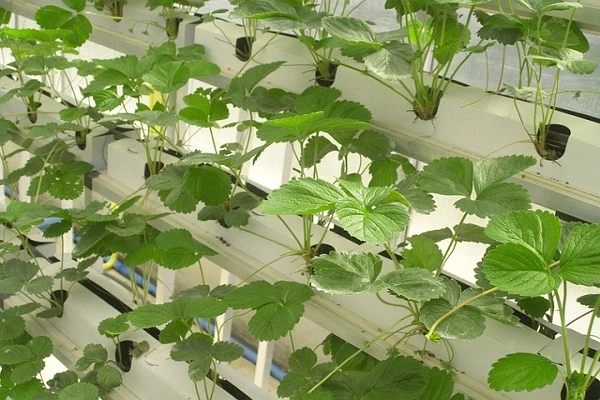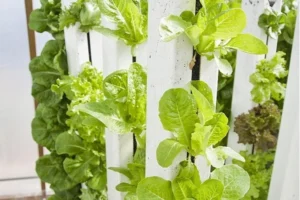Imagine having fresh basil, mint, or cilantro at your fingertips whenever you need it—without stepping outside or worrying about soil conditions. That’s the beauty of vertical hydroponic gardening. Unlike traditional gardening, which requires large outdoor spaces and soil, hydroponic systems allow plants to grow in nutrient-rich water, often in stacked or vertical arrangements. This method not only saves space but also maximizes efficiency, making it perfect for urban dwellers and home gardeners alike.
Growing fresh herbs at home comes with a range of benefits. First, it’s incredibly convenient—you no longer have to run to the store for a handful of parsley or thyme. Second, vertical hydroponic systems are space-efficient, allowing you to grow a variety of herbs even in small apartments or limited indoor spaces. Lastly, hydroponics provides a year-round growing solution, meaning you can enjoy fresh, homegrown herbs no matter the season.
This article will walk you through everything you need to know to set up and maintain a successful vertical hydroponic herb garden. From choosing the right system and selecting the best herbs to setting up your garden and keeping it thriving, we’ll cover all the essentials to help you get started with this modern and sustainable way of growing herbs at home.
Choosing the Right System
If you’re new to hydroponics, choosing the right vertical system might feel overwhelming. Fortunately, there are a few tried-and-true options that make growing fresh herbs at home easy and efficient. The two most popular vertical hydroponic systems are the Nutrient Film Technique (NFT) and tower gardens.
The Nutrient Film Technique (NFT) involves a continuous, shallow flow of nutrient-rich water running through a sloped channel. The roots of the plants absorb nutrients while also getting oxygen from the air. This method is great for growing lightweight herbs and is often used in commercial hydroponic farms.
Tower gardens, on the other hand, are compact, space-saving systems that work by circulating water from a reservoir to multiple plant levels. Some use aeroponics, where the roots are misted with nutrients, while others use a recirculating water system. These are ideal for home gardeners because they take up little space and require minimal maintenance.
When selecting the best system for your home, consider three key factors: space, budget, and the number of plants you want to grow. If you live in an apartment or have limited space, a tower garden might be the best choice due to its vertical design. If you’re looking to grow a larger number of herbs, an NFT system may be more efficient. Budget also plays a role—some systems require more initial investment but offer better long-term yields.
Selecting Herbs for Hydroponic Growth
Not all herbs thrive in hydroponic systems, but many do exceptionally well. Some of the best options include:
- Basil – Fast-growing and perfect for everything from pesto to salads.
- Mint – A vigorous grower that thrives in hydroponic conditions.
- Cilantro – Grows quickly and is a must-have for salsas and curries.
- Parsley – Easy to grow and great for garnishing dishes.
- Chives – A hardy herb that adds a mild onion flavor to dishes.
- Thyme and oregano – Great for cooking and thrive with the right light conditions.
When choosing which herbs to grow, think about your climate and culinary preferences. Since hydroponic gardens can be grown indoors, climate is less of a concern, but some herbs still have specific needs. For example, basil thrives in warm temperatures, while cilantro prefers cooler conditions. Also, consider what you’ll actually use in your cooking. If you frequently cook Italian dishes, basil and oregano are must-haves. If you enjoy fresh herbal tea, mint and lemon balm are great choices.
Setting Up the Vertical Hydroponic Garden
Setting up a vertical hydroponic garden might sound technical, but it’s surprisingly manageable with the right components and a clear plan. The key is to create an environment where plants receive optimal light, nutrients, and water circulation. A well-designed system not only supports healthy plant growth but also fits seamlessly into small living spaces—whether it’s a sunny kitchen corner or a dedicated indoor garden nook.
Here are the essential components you’ll need:
- Vertical Grow Structure: This could be a pre-built tower garden, a DIY PVC pipe system, or a shelf-based NFT setup. Look for systems that allow easy access to each plant and ensure proper spacing for airflow and light penetration.
- Water Reservoir: Acts as the heart of the system, storing and recirculating the nutrient solution. It should be opaque to prevent algae growth and large enough to support the number of plants you’re growing.
- Submersible Water Pump: Circulates water through the system, ensuring that nutrients reach each plant’s roots consistently. Choose a pump rated for your system’s size and height.
- Nutrient Solution: A specially formulated mix of essential minerals like nitrogen, potassium, calcium, and magnesium. Liquid hydroponic nutrients are widely available and come in blends tailored for herbs.
- Growing Medium: Since you’re not using soil, plants need a medium like Rockwool, coconut coir, clay pellets, or grow sponges to anchor their roots and hold moisture.
- Grow Lights (for indoor setups): Full-spectrum LED grow lights mimic natural sunlight and are essential if your space lacks sufficient natural light. Adjustable fixtures are ideal for vertical setups.
- Timer and pH Tools: A timer automates your light cycles, and a digital pH meter helps maintain the optimal pH level of 5.5 to 6.5. These tools take the guesswork out of daily care.
Planning your layout is also important. Make sure the system’s vertical height fits your space, and allow for easy maintenance access. Consider using a waterproof mat or tray underneath to protect your flooring from potential spills or leaks.
Step-by-Step Setup Guide:
Assemble Your System
Follow the instructions specific to your vertical garden or DIY system. Ensure the structure is level and secure. For tower systems, stack modules according to the manufacturer’s guide. For NFT setups, position the channels with a slight slope for water flow. Test all joints and seals to avoid leaks.
Install the Pump and Reservoir
Place the reservoir at the system’s base and connect the water pump to the irrigation tubing. The pump should be submerged and securely placed. Run a dry test to check water circulation and flow rate before adding plants or nutrients.
Mix and Test the Nutrient Solution
Fill the reservoir with clean, filtered water and add your hydroponic nutrients according to label instructions. Stir well to ensure even distribution. Use a pH meter to adjust the solution to a range between 5.5 and 6.5 using pH up/down solutions. Let the mixture sit for an hour and recheck levels before use.
Prepare and Insert Your Plants
Use seedlings or rooted cuttings for best results. Place them in net pots filled with your chosen growing medium. Insert the net pots into the planting holes in your system. Ensure the roots can reach or are near the flowing nutrient solution without being completely submerged.
Start Water Circulation
Turn on the pump and monitor the flow to ensure even distribution. Check for leaks or blockages, and confirm that each plant site receives consistent water exposure. Water should flow smoothly, not pool or dry out at any level.
Set Up Grow Lights
If indoors, mount full-spectrum LED grow lights above the system, about 6–12 inches above the plant tops. Use a timer to provide 12–16 hours of light per day, mimicking natural daylight cycles.
Monitor and Adjust
In the first few days, check water levels, pH, and nutrient concentration daily. After your system stabilizes, monitor it a few times a week. Keep an eye on plant health, watch for root development, and adjust light height as plants grow.
By following these steps, your vertical hydroponic garden will be well-equipped to grow fresh, flavorful herbs with minimal maintenance and maximum efficiency.
Caring for Herbs in a Hydroponic System
Once your system is up and running, ongoing care is essential to keep your herbs thriving. The three main factors to monitor are lighting, nutrient balance, and potential issues like root rot or pests.
Lighting, Temperature, and Humidity Control
Hydroponic herbs need sufficient light to grow. If using artificial grow lights, keep them on for about 12-16 hours a day. Position the lights correctly—too close, and the plants might burn; too far, and they might not get enough energy.
Temperature is another important factor. Most herbs grow best between 65-75°F (18-24°C). If your system is indoors, avoid placing it near air vents or drafty windows. Humidity levels should also be moderate to prevent mold growth.
Maintaining Nutrient Balance and pH Levels
A hydroponic system eliminates the need for soil, but plants still need nutrients. Most hydroponic nutrient solutions contain essential minerals like nitrogen, phosphorus, and potassium, along with trace elements such as magnesium and calcium.
- To ensure your plants receive the right nutrients:
- Check the pH level weekly. A pH between 5.5 and 6.5 is ideal for most herbs.
- Replace the nutrient solution every two weeks to prevent imbalances.
- Monitor plant growth—if leaves start yellowing, it could indicate a nutrient deficiency.
Common Issues and How to Prevent Them
Even in a controlled environment, hydroponic gardens can run into occasional problems. Here are a few common ones and how to handle them:
- Root Rot – Often caused by poor water circulation or excessive moisture. To prevent it, ensure your system is aerated and avoid overwatering.
- Algae Growth – Algae can develop in nutrient reservoirs exposed to light. Keep the reservoir covered and clean it regularly.
- Pests – While hydroponic gardens generally have fewer pests than soil-based gardens, aphids and spider mites can still appear. Check plants regularly and use organic pest control methods if needed.
By maintaining proper light, nutrients, and environmental conditions, you’ll be able to keep your hydroponic herb garden healthy and productive all year long.
Final Words
Vertical hydroponic gardening offers a convenient, space-saving way to grow fresh herbs year-round—perfect for small apartments. With the right system, proper care, and a bit of experimentation, anyone can enjoy a steady supply of flavorful, homegrown herbs. Whether you’re using basil for pesto or mint for tea, hydroponics makes it easy to harvest fresh ingredients whenever you need them. The process is rewarding, sustainable, and a great way to enhance your cooking while embracing modern gardening techniques.




